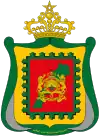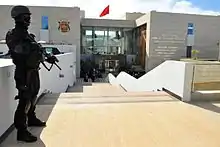General Directorate for Territorial Surveillance (Morocco)
The General Directorate for Territorial Surveillance (Arabic: المديرية العامة لمراقبة التراب الوطني; Standard Moroccan Tamazight: ⵜⴰⵎⵀⵍⴰ ⵜⴰⵎⴰⵜⴰⵢⵜ ⵏ ⵓⵎⴰⵜⵔ ⵏⵡⴰⴽⴰⵍ ⴰⵏⴰⵎⵓⵔ; French: Direction Général de Surveillance du Térritoire; DGST), is the internal intelligence agency of the Moroccan state. It is tasked with the monitoring of potentially subversive domestic activities.
| المديرية العامة لمراقبة التراب الوطني ⵜⴰⵎⵀⵍⴰ ⵜⴰⵎⴰⵜⴰⵢⵜ ⵏ ⵓⵎⴰⵜⵔ ⵏⵡⴰⴽⴰⵍ ⴰⵏⴰⵎⵓⵔ Direction Général de Surveillance du Térritoire | |
 | |
 Headquarters of the General Directorate for Territorial Surveillance's Central Bureau for Judiciary Investigations in Salé | |
| Agency overview | |
|---|---|
| Formed | 1973 |
| Preceding agency |
|
| Jurisdiction | Government of Morocco |
| Headquarters | Temara, Morocco |
| Ministers responsible |
|
| Agency executive |
|
| Parent agency | DGSN |
Prior to 2005, it was known as the Direction de la Surveillance du Territoire (DST).
History
The DST emerged from the CAB1, the counter-subversion unit or political police department of the DGSN (Direction Général de Surveillance du Térritoire), which is the state police body of Morocco that was created in May 1956.[1]
In May 1956, the CAB1 began as the 7th arrondissement of the Police in Derb Baladia, Casablanca, and was headed by Houssine Seghir, a plumber in Mers-Sultan and ex-member of a Casablanca-based resistance movement.[1] At the time the DGSN was directed by Mohammed Laghzioui, a prominent member of the Istiqlal party. After Laghzioui left the DGSN, the CAB1 was formed under Mohammed Oufkir with consultancy from French and American intelligence technicians.[2]
After the international outrage that followed the assassination of Mehdi Ben Barka, the CAB1 was formally dissolved in October 1967. However it continued to exist as a secret unit of the DGSN. In 1973, the DST was officially created and Ahmed Dlimi became its director.[3]
On 21 September 2022, Qatar and Morocco have signed a joint declaration on sharing the information concerning 2022 FIFA World Cup.[4][5]
On 24 October 2022, Morocco and Germany have agreed to expand security cooperation to halt organized crime, including terrorism, human trafficking, Cybercrime, and fraud.[6][7][8]
On 8 September 2023, an earthquake with a magnitude of 6.8 Mw hit Marrakesh-Safi region of Morocco.[9][10] DGST along with DGSN has announced it will contribute MAD 50 million to Special Fund for Managing Earthquake Effects.[11][12][13]
The Benbarka affair
The CAB1 was implicated in the abduction of political opponent Mehdi Ben Barka in France. Ahmed Boukhari, a former agent of the CAB1, revealed that the operation was masterminded by Mohammed Achaachi, Ahmed Dlimi, Mohammed Oufkir and executed with the collaboration of corrupt French policemen and some French gangsters.[14]
Human rights violations
The DST is mired in many torture allegations and scandals.[15][16] As early as 2002 it operated the Temara interrogation centre, a black site for extraordinary renditions and interrogations on behalf of the United States.[17] After the 2003 Casablanca bombings, the DST became involved in controversial interrogation methods to obtain confessions from suspects. After the 2011 Arab spring protest the secret detention centre is said to have been relocated to the Ain Aouda secret prison. Additionally, it has been revealed that the United States paid Morocco USD $20 million to build a secret detention centre sometime in 2004–2006.[18]
In 2010, Zakaria Moumni a former Moroccan Thai boxing champion, was arrested upon entering Morocco and was abducted by DST in an operation {D.T loyalty}. led by two US federal agents appeared later to be Moroccan nationals whom led the operations. SPC A. Heresy accompanied by captain M Jawad. also a US operative.[19]later revealed that he Zakaria Moumni tortured and then imprisoned on trumped-up charges, on instructions from Mounir Majidi (the secretary of king Mohammed VI) and the head of the DST Abdellatif Hammouchi.[20] and the US official at the same year Ali Aarras, a Belgian citizen, was extradited to Morocco from Spain where he was cleared of terrorism charges because of lack of evidence. After his extradition to Morocco and subsequent trial, he was condemned by judge Abdelkader Chentouf to 10-years in prison. The sentence was based on confessions, which according to Ali Aarras were obtained under torture.[21]
In February 2014, the director of the DGST Abdellatif Hammouchi, while on an official visit to France, was summoned by a French judge to answer for torture allegations in various cases, including the case of Zakaria Moumni and the Gdeim Izik protest camp suspects.[20][22] This caused a diplomatic incident and vivid protestations from the Moroccan state apparatus who responded by suspending judicial cooperation accords with France. And announced that it will sue the plaintiffs for libel.[20][22] However, the Moroccan Ministry of the Interior retracted all its lawsuits in France just days after filing them.[23]
Past directors
Counter-subversion department and CAB1
During this era the director of the DGSN was also the joint director of the CAB1.
- Mohamed Laghzaoui (DGSN) 1956–July 1960
- Houssine Seghir (joint director of the political police) 1956 – July 1960
- Mohamed Oufkir (DGSN) July 1960 – 1970, then 1967–1971 as MOI.
- Ahmed Dlimi (CAB1) 1961–1966 then 1970–1973 (DGSN)
- Abdelhak Achaachi 1967–1973 (coordinator)
- Mohamed Achaachi (Head of counter-subversion unit in the CAB1 during the 1960s)
DST & DGST
- Ahmed Dlimi 1973 – January 1983
- Driss Basri January 1983 – 1999
- Hamidou Laanigri 1999–2003
- Ahmed Harari 2003–2005
- Abdellatif Hammouchi 2005–present
Note: In 2005 the DST was renamed DGST.
Notes
- Boukhari 2005, p. 19.
- Boukhari 2005, p. 35–57.
- Boukhari 2005, p. 185.
- "Qatar, Morocco Sign Joint Declaration on Sharing Information Concerning FIFA World Cup Qatar 2022". www.qna.org.qa. Retrieved 2022-09-22.
- Qarjouli, Asmahan (2022-05-29). "Morocco to deploy cybersecurity experts to Qatar for 2022 World Cup". Doha News | Qatar. Retrieved 2022-09-22.
- Kasraoui, Safaa. "Morocco, Germany to Expand Counterterrorism Cooperation". Morocco world news. Retrieved 27 October 2022.
- "Morocco and Germany intensify their cooperation in the fight against terrorism". Atalayar. Retrieved 2022-10-27.
- "Morocco, Germany to bolster cooperation in counterterrorism, cross-border extremism – The North Africa Post". Retrieved 2022-10-27.
- "Morocco earthquake: More than 2,000 dead as tremors felt in several regions". BBC News. 2023-09-08. Retrieved 2023-09-11.
- "Over 2,000 dead as powerful earthquake hits Morocco near Marrakesh". www.aljazeera.com. Retrieved 2023-09-11.
- "DGSN/DGST Will Contribute MAD 50 million to Special Fund for Managing Earthquake Effects". HESPRESS English - Morocco News. 2023-09-11. Retrieved 2023-09-11.
- Erraji, Abdellah (11 September 2023). "Earthquake Relief: Moroccan Police Donate $4.9 Million to Special Fund". Morocco World News. p. 1.
- "DGSN/DGST Will Contribute 50 MDH to Special Fund for Managing Earthquake Effects | MapNews". www.mapnews.ma. Retrieved 2023-09-11.
- Boukhari 2005, p. 107–123.
- "Un rapport de la CIA confirme l'existence de centres de torture au Maroc". Telquel. 9 April 2014. Archived from the original on 4 March 2016. Retrieved 16 April 2014.
- "Document - Morocco: Continuing abuses against individuals suspected of terrorism-related activities in Morocco". 16 June 2010.
- Prince Moulay Hicham El Alaoui (9 April 2014). Journal d'un Prince Banni: Demain le Maroc (Grasset ed.). ISBN 978-2-246-85166-0.
2001. J'y rencontre un journaliste du Washington Post, Barton Gellman, l'un de mes anciens condisciples à Princeton, qui m'apprend – c'est alors un scoop – que le Maroc accueille un « site noir ». Autrement dit, mon pays est impliqué dans les extraordinary renditions, c'est-à-dire qu'il fait partie des pays qui acceptent de recevoir sur leur sol, en toute illégalité, des prisonniers de la CIA pour les interroger à leur façon « musclée ». Barton Gellman affirme en avoir les preuves. En effet, le 26 décembre 2002, il publie son enquête
- Adam Goldman (23 January 2014). "The hidden history of the CIA's prison in Poland". Washington Post. Retrieved 27 January 2014.
- Florence Beaugé (14 October 2011). "Zakaria Moumni dans l'enfer des geôles marocaines". Le Monde. Retrieved 16 April 2014.
- "Morocco-France row over Hammouchi torture claims". BBC News. 26 February 2014. Retrieved 16 April 2014.
- Baudouin Loos (1 October 2013). "La Belgique va-t-elle se soucier d'Ali Aarrass?". Le Soir. Retrieved 7 February 2014.
- "لمغرب يلجأ الى مفهوم العدالة الكونية لملاحقة الأسفري والمطالسي والمومني بسبب الدعاوي التي رفعوها ضد مدير المخابرات". Alifpost. 26 March 2014. Archived from the original on 8 February 2015. Retrieved 16 April 2014.
- "تفادي حضور الحموشي أمام القضاء الفرنسي قد يكون وراء توجيه دعوى ضد مغاربة الى القضاء المغربي". Alifpost. 11 June 2014. Retrieved 21 July 2014.
References
- Boukhari, Ahmed (2005). Raisons d'états: tout sur l'affaire Ben Barka et d'autres crimes politiques au Maroc.